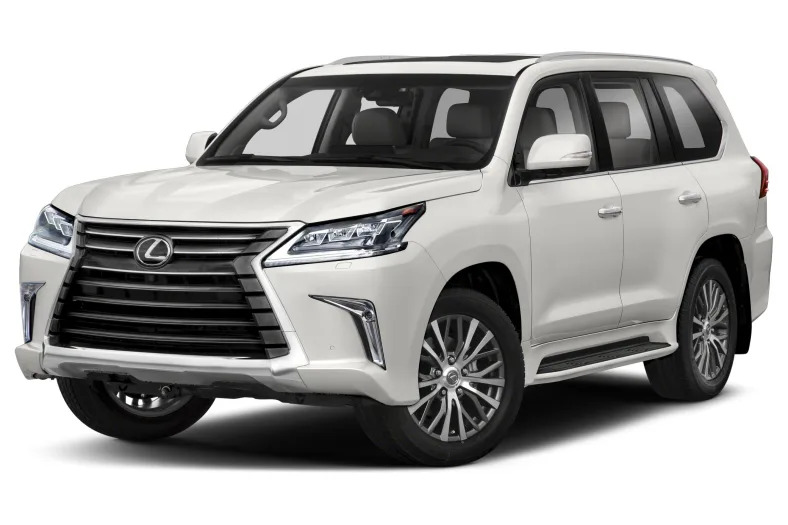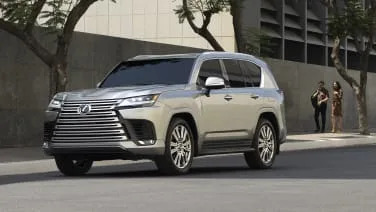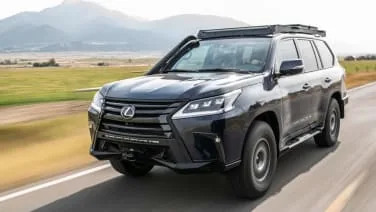Two-Row 4dr 4x4
2020 Lexus LX 570
There’s no need to explain the Toyota Land Cruiser, one of Toyota’s earliest successful products. The 2020 Toyota Land Cruiser Heritage Edition celebrates some 60 years of popularity of a vehicle that has survived the segment’s “mall wagon” phase and the rise of crossovers. Its already-sterling reputation has received an additional recent push from the rise of overlanding — an outdoor pastime that has always existed but only recently got a press agent. By comparison, the Lexus LX is a more recent development. Debuting in 1996, the LX 450 was little more than an 80-series Land Cruiser with cladding, a Lexus badge and a higher price. The amount of styling differentiation and luxury specialization has increased over the years to the point that the newest LX 570 actually seems like a completely different vehicle. In truth, the 2020 Lexus LX 570 and the 2020 Toyota Land Cruiser are both 200-series Land Cruisers under the skin. They share the same thirsty 5.7-liter V8 engine and the same frame that features a double-wishbone suspension at the front, a five-link coil spring suspension at the rear and a 112.2-inch wheelbase in the middle. The styling is strikingly different, of course, but so are the hidden details of their suspensions. The Land Cruiser employs a simple set of coil springs and shock absorbers, but with an interconnected pair of automatically disconnecting stabilizer bars called KDSS (Kinetic Dynamic Suspension System). The Lexus, on the other hand, has fixed stabilizer bars and coil springs, but its “shocks” are really hydraulic cylinders that perform height adjustments and transmit suspension movements via piping to remote electronically-adjustable damper valves mounted along the frame rails. All of the above begs a question: Which of them will go farther up my RTI ramp and, by extension, offer better suspension articulation in an authentic off-road situation? Right away, the very approach to the ramp demonstrates a huge difference and a serious issue for the LX. Its normal cruising height (there is a lower height, but this isn’t that) doesn’t provide enough approach clearance to attempt the ramp. The front spoiler contacts the nasty grating before the tire does. It’s a close-run thing, but from this point on, clearance gets SMALLER as the left front suspension compresses on the way up. If it's touching now, it’s only going to get worse if I go forward. It must be noted that this LX570 test sample is fitted with the optional “Sport Package” that consists of, among other things, an even more aggressively-styled front fascia with built in “spoilers” that do a fantastic job of living up to the primary definition of the word by ruining approach clearance directly in front of the tires. Things surely would have been different if this LX 570 lacked this $2,510 appearance package. But our LX 570 isn’t out of this fight yet. Its four-wheel height control system includes a switch that raises the front 2 inches and the rear 2.4 inches. That’s more than enough to give it …
Full Review
There’s no need to explain the Toyota Land Cruiser, one of Toyota’s earliest successful products. The 2020 Toyota Land Cruiser Heritage Edition celebrates some 60 years of popularity of a vehicle that has survived the segment’s “mall wagon” phase and the rise of crossovers. Its already-sterling reputation has received an additional recent push from the rise of overlanding — an outdoor pastime that has always existed but only recently got a press agent. By comparison, the Lexus LX is a more recent development. Debuting in 1996, the LX 450 was little more than an 80-series Land Cruiser with cladding, a Lexus badge and a higher price. The amount of styling differentiation and luxury specialization has increased over the years to the point that the newest LX 570 actually seems like a completely different vehicle. In truth, the 2020 Lexus LX 570 and the 2020 Toyota Land Cruiser are both 200-series Land Cruisers under the skin. They share the same thirsty 5.7-liter V8 engine and the same frame that features a double-wishbone suspension at the front, a five-link coil spring suspension at the rear and a 112.2-inch wheelbase in the middle. The styling is strikingly different, of course, but so are the hidden details of their suspensions. The Land Cruiser employs a simple set of coil springs and shock absorbers, but with an interconnected pair of automatically disconnecting stabilizer bars called KDSS (Kinetic Dynamic Suspension System). The Lexus, on the other hand, has fixed stabilizer bars and coil springs, but its “shocks” are really hydraulic cylinders that perform height adjustments and transmit suspension movements via piping to remote electronically-adjustable damper valves mounted along the frame rails. All of the above begs a question: Which of them will go farther up my RTI ramp and, by extension, offer better suspension articulation in an authentic off-road situation? Right away, the very approach to the ramp demonstrates a huge difference and a serious issue for the LX. Its normal cruising height (there is a lower height, but this isn’t that) doesn’t provide enough approach clearance to attempt the ramp. The front spoiler contacts the nasty grating before the tire does. It’s a close-run thing, but from this point on, clearance gets SMALLER as the left front suspension compresses on the way up. If it's touching now, it’s only going to get worse if I go forward. It must be noted that this LX570 test sample is fitted with the optional “Sport Package” that consists of, among other things, an even more aggressively-styled front fascia with built in “spoilers” that do a fantastic job of living up to the primary definition of the word by ruining approach clearance directly in front of the tires. Things surely would have been different if this LX 570 lacked this $2,510 appearance package. But our LX 570 isn’t out of this fight yet. Its four-wheel height control system includes a switch that raises the front 2 inches and the rear 2.4 inches. That’s more than enough to give it …
Hide Full Review
Hide Full Review
Retail Price
$86,480
MSRP / Window Sticker Price
| Engine | 5.7L V-8 |
| MPG | 12 City / 16 Hwy |
| Seating | 5 Passengers |
| Transmission | 8-spd auto w/OD |
| Power | 383 @ 5600 rpm |
| Drivetrain | four-wheel |
Smart Buy Program is powered by 





